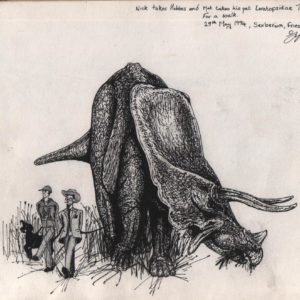
Walking With Triceratops
Walking With Triceratops
A favourite pencil, pen and ink drawing of Nick, walking his dog and Matthew, walking his Triceratops. 19cm x 14cm (image size). 31cm x 26cm (framed size).
The dinosaur belongs to a genus of herbivorous ceratopsid dinosaur that first appeared during the late Maastrichtian stage of the late Cretaceous period, about 68 million years ago (mya) in what is now North America. It is one of the last known non- avian dinosaur genera, and became extinct in the Cretaceous–Paleogene extinction.
The dinosaur’s name, which literally means “three-horned face”, is derived from the Greek τρί- (tri-) meaning “three”, κέρας (kéras) meaning “horn”, and ὤψ (ops) meaning “face”. It has been documented by numerous remains collected since the genus was first described in 1889, including at least one complete individual skeleton. Paleontologist John Scannella observed: “It is hard to walk out into the Hell Creek Formation and not stumble upon a Triceratops weathering out of a hillside.” Forty-seven complete or partial skulls were discovered in just that area from 2000 to 2010. Specimens representing life stages from hatchling to adult have been found. As the archetypal ceratopsid, Triceratops is one of the most popular dinosaurs, and has been featured in film, postal stamps, and many other types of media.
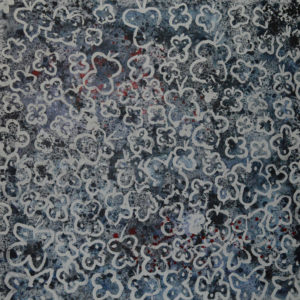
Lepidoptera No.5 – The Great Grey Fluttering
Lepidoptera No.5 – The Great Grey Fluttering is a 100cm (H) x 100cm (W) x 3.5cm (D) acrylic painting. I have used patches of crimson, Paynes grey and titanium white and masking fluid to reveal one hundred, fluttering butterflies. This is the largest of the Lepidoptera series… so far! This painting was painted in the Spring of 2018 and joins the four other butterfly paintings in this series. I enjoy this form of expression so I will add to this collection in the future.
Butterflies are insects in the Order Lepidoptera, which also includes moths. Adult butterflies have large, often brightly coloured wings, and conspicuous, fluttering flight. Butterfly fossils date to the Paleocene, which was about 56 million years ago.
Butterflies have the typical four-stage insect life cycle. Winged adults lay eggs on the food plant on which their larvae, known as caterpillars, will feed. The caterpillars grow, sometimes very rapidly, and when fully developed, pupate in a chrysalis. When metamorphosis is complete, the pupal skin splits, the adult insect climbs out, and after its wings have expanded and dried, it flies off. Some butterflies, especially in the tropics, have several generations in a year, while others have a single generation, and a few in cold locations may take several years to pass through their entire life cycle.
Butterflies are often polymorphic, and many species make use of camouflage, mimicry and aposematism to evade their predators. Some, like the monarch and the painted lady, migrate over long distances. Many butterflies are attacked by parasites or parasitoids, including wasps, protozoans, flies, and other invertebrates, or are preyed upon by other organisms. Some species are pests because in their larval stages they can damage domestic crops or trees; other species are agents of pollination of some plants. Larvae of a few butterflies (e.g., harvesters) eat harmful insects, and a few are predators of ants, while others live as mutualists in association with ants. Culturally, butterflies are a popular motif in the visual and literary arts.
(most text abridged from the wikipedia page on Butterflies)
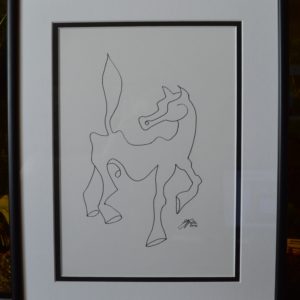
Prancing Pony
Prancing Pony
Prancing Pony is an A4 (21 x 30cm) , framed (25 x 35cm), ink line drawing of an Arab dressage pony. The simple line gives a sense of elegance and movement whilst keeping the drawing clean and tidy. I was inspired, like so many, by the grace of Arabian stallions when they compete in dressage events and I also have a colleague who competes in the events so it reminds me of him and his wife.
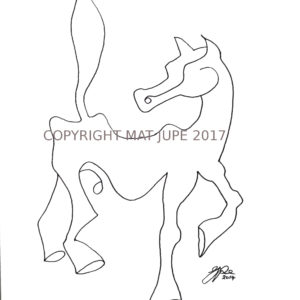
Prancing Pony – Limited Edition Print
Prancing Pony – Limited Edition Print
Prancing Pony – Limited Edition Print. A limited edition of 10 A4 (21 x 30cm)unmounted giclee prints are available.
Prancing Pony is an A4, copy of an ink line drawing of an Arab dressage pony. The simple line gives a sense of elegance and movement whilst keeping the drawing clean and tidy. I was inspired, like so many, by the grace of Arabian stallions when they compete in dressage events and I also have a colleague who competes in the events so it reminds me of him and his wife.
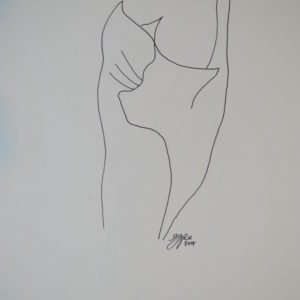
How Many Cats?
How Many Cats?
This ink drawing is a simple A4 line, from 2014, that begs the question ‘How many cats do you see on the page?’. I can see at least three but who am I to tell. *big smile*